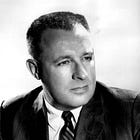Denis Villeneuve: The New Kubrick of Sci-Fi Cinema?
Kubrick's seminal work, 2001: A Space Odyssey (1968), not only revolutionized the genre but also set an almost unreachable standard for future directors. Yet, in recent years, a new voice has emerged.
The world of science fiction cinema has always been a fertile ground for visionary filmmakers who push the boundaries of storytelling, visual effects, and philosophical inquiry. Among these giants, Stanley Kubrick stands as a towering figure, revered for his meticulous craftsmanship and intellectual rigor. His seminal work, 2001: A Space Odyssey (1968), not only revolutionized the genre but also set an almost unreachable standard for future directors. Yet, in recent years, a new voice has emerged, drawing comparisons to Kubrick’s legacy—Denis Villeneuve.
Villeneuve, known for his visually stunning and thematically rich films, has rapidly established himself as one of the most significant directors in contemporary cinema. His work in science fiction, particularly with films like Arrival (2016) and Blade Runner 2049 (2017), has sparked discussions about his place in the pantheon of great directors. The question on many cinephiles’ minds is: Could Denis Villeneuve be the new Kubrick? This comparison invites a deeper exploration of their respective oeuvres, examining the visual precision, thematic depth, and narrative styles that have defined their contributions to science fiction.
Visual and Aesthetic Precision
Kubrick's films are known for their meticulous craftsmanship, precision in framing, and visual symbolism. This is perhaps most evident in 2001: A Space Odyssey (1968), a landmark in science fiction that redefined the genre with its groundbreaking special effects, enigmatic narrative, and philosophical depth. Kubrick's use of long takes, symmetrical compositions, and an almost clinical attention to detail created a sense of the sublime and the uncanny. His vision of the future was both awe-inspiring and unsettling, filled with vast, empty spaces that spoke to the loneliness of human existence in the cosmos.
Villeneuve, similarly, is recognized for his visual mastery. In Blade Runner 2049 (2017), a sequel to Ridley Scott's Blade Runner (1982), Villeneuve created a dystopian world that is both expansive and intimate, maintaining a careful balance between visual spectacle and narrative depth. His use of color, lighting, and production design is highly deliberate, creating a mood that is both melancholic and reflective. Like Kubrick, Villeneuve’s films often explore the tension between human emotion and a cold, indifferent universe.
Thematic Exploration
Kubrick's science fiction work, particularly 2001: A Space Odyssey, delves into themes of human evolution, artificial intelligence, and the unknowable nature of the universe. The film’s ambiguous ending, with the transformation of Dave Bowman into the Star Child, leaves audiences questioning the meaning of existence and humanity's place in the cosmos. Similarly, A Clockwork Orange (1971), though not strictly science fiction, explores the darker aspects of human nature, free will, and societal control.
Villeneuve, on the other hand, often explores the intersection of technology, identity, and memory. In Arrival (2016), he examines the nature of time and language, using the arrival of extraterrestrial beings as a metaphor for understanding and communication. The film’s non-linear narrative challenges viewers’ perceptions of time, much like Kubrick’s manipulation of time and space in 2001. In Blade Runner 2049, Villeneuve explores themes of artificial intelligence and what it means to be human, echoing the philosophical inquiries that Kubrick posed in his work.
Narrative Style
Kubrick’s narrative style is often described as cold, detached, and deliberately paced. His films resist easy interpretation, instead inviting viewers to engage in active reflection. The enigmatic monoliths in 2001 and the ambiguous ending of The Shining (1980) exemplify his commitment to creating films that challenge rather than comfort the audience.
Villeneuve’s narratives, while also slow-paced and contemplative, tend to be more emotionally resonant. His characters are often more fully fleshed out than Kubrick’s, providing a stronger emotional anchor for viewers. This is particularly evident in Arrival, where the protagonist’s emotional journey is central to the film’s impact. Villeneuve’s ability to blend emotion with intellectual rigor creates a different but equally powerful experience compared to Kubrick’s more austere approach.
Influence on Science Fiction Cinema
Kubrick’s influence on science fiction cinema is immeasurable. 2001: A Space Odyssey set a new standard for the genre, influencing countless filmmakers and shaping the way science fiction is visualized and understood. His work continues to be a touchstone for discussions about the genre’s potential to explore complex philosophical questions.
Villeneuve, while still relatively early in his career compared to Kubrick, is already making a significant impact on the genre. Blade Runner 2049 and Arrival have both been praised for their depth and artistry, and his adaptation of Dune (2021) further cements his reputation as a visionary director in the realm of science fiction. Villeneuve’s work is helping to push the boundaries of the genre, much like Kubrick did in his time.
Sound Design and Musical Influence
Sound and music play a crucial role in shaping the atmosphere and emotional resonance of both Kubrick's and Villeneuve's films, particularly in their science fiction works. Kubrick's collaborations with classical music composers like Richard Strauss and György Ligeti in 2001: A Space Odyssey created a soundscape that was as iconic as the visuals. The use of "Also sprach Zarathustra" and the eerie, dissonant compositions of Ligeti lent the film an otherworldly quality, reinforcing its themes of the unknown and the sublime. Kubrick’s ability to synchronize music with visuals, such as the famous docking sequence to "The Blue Danube," created a poetic, almost balletic experience that has become a hallmark of his style.
Villeneuve, while not relying on classical music, has similarly harnessed the power of sound and music to amplify the emotional and thematic impact of his films. His collaboration with composer Jóhann Jóhannsson in Arrival resulted in a haunting, minimalist score that underscores the film's exploration of time and memory. In Blade Runner 2049, Villeneuve worked with Hans Zimmer and Benjamin Wallfisch to create a score that pays homage to Vangelis' original while pushing it into new, atmospheric territory. The deep, resonant synths and ambient tones mirror the film’s bleak, dystopian setting, creating a sense of vastness and melancholy that echoes Kubrick’s use of sound to evoke the grandeur and isolation of space.
Legacy and Future Impact
One of the most compelling aspects of comparing Kubrick and Villeneuve is considering the legacy they leave behind and how future filmmakers might draw from their work. Kubrick’s influence is deeply embedded in the DNA of modern science fiction. His willingness to challenge narrative conventions, coupled with his use of innovative special effects and sound design, has inspired generations of directors. Films like Christopher Nolan’s Interstellar (2014) and Alfonso Cuarón’s Gravity (2013) owe a clear debt to Kubrick’s visionary work in 2001: A Space Odyssey. Kubrick’s impact extends beyond the genre, influencing the broader cinematic landscape with his unyielding pursuit of perfection and his ability to blend entertainment with intellectual depth.
Villeneuve, while still actively contributing to the genre, is already shaping the future of science fiction cinema. His adaptation of Dune has set a new standard for epic storytelling within the genre, and his thoughtful approach to filmmaking—blending visual spectacle with deep philosophical questions—ensures that his films will be studied and revered for years to come. As Villeneuve continues to evolve as a filmmaker, his influence will likely grow, inspiring a new generation of directors who seek to combine emotional resonance with intellectual rigor in their science fiction storytelling.
WHILE THEIR APPROACHES DIFFER…
As we reflect on the contributions of Stanley Kubrick and Denis Villeneuve to science fiction cinema, it becomes clear that while their approaches differ, both directors have profoundly shaped the genre. Kubrick’s films, with their cold precision and philosophical ambiguity, continue to influence filmmakers and challenge audiences to this day. His work set a standard for what science fiction could achieve, blending high-concept ideas with groundbreaking visuals to explore the deepest questions of human existence.
Villeneuve, while still building his legacy, has already left a significant mark on the genre. His films resonate with a contemporary audience, blending emotional depth with intellectual exploration in a way that feels both familiar and fresh. Villeneuve’s ability to create immersive worlds that invite both reflection and emotional engagement suggests that he is more than just a successor to Kubrick—he is a visionary in his own right, one who is continuing the evolution of science fiction cinema.
In the end, whether or not Villeneuve is “the new Kubrick” may be less important than recognizing that he is part of a lineage of directors who use science fiction not just to entertain, but to explore the very fabric of our existence. In doing so, Villeneuve stands shoulder to shoulder with Kubrick, continuing the tradition of using cinema as a tool for both visual and philosophical exploration.
What do you think? Is he the new Kubrick of sci-fi cinema?













Amazing directors! I’m obsessed with all these movies you mentioned. I just posted about a huge Space Odyssey tattoo I finished. Cheers!